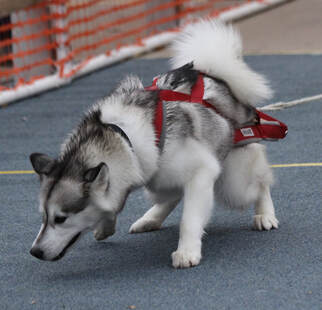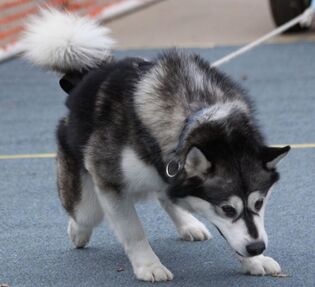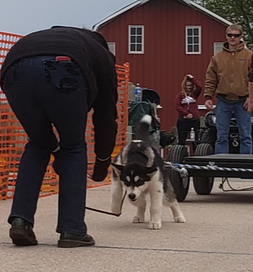 "Ciara." Owned by Karina Burger and Tim O'Brien.
"Ciara." Owned by Karina Burger and Tim O'Brien.
The Minnesota Malamute Club sponsors a spring (May), fall (September), and winter weekend of weight pulls. These are usually two-day events - AMCA pulls held in conjunction with UKC - with novice and puppy pulls offered.
What is weight-pulling?
Weight-pulling tests both a dog's physical and mental fortitude. Can the dog physically pull its own weight, several times over? Does it believe that it can? Half the battle is convincing them that they can do it, to just put down their head and pull.
What is weight-pulling?
Weight-pulling tests both a dog's physical and mental fortitude. Can the dog physically pull its own weight, several times over? Does it believe that it can? Half the battle is convincing them that they can do it, to just put down their head and pull.
 "Orion." Owned by Karina Burger and Tim O'Brien.
"Orion." Owned by Karina Burger and Tim O'Brien.
How are weight-pulls done?
Dogs are divided into five divisions according to their body weight (<60, 61-80, 81-100, 101-120, 120+). Weight pulling is a timed event in which the dog has 60 seconds to pull the weight 16 feet. An AMCA leg requires that the dog pull over or equal to 12x their weight on the day of the pull. The owner or handler cannot touch the dog during the pull. Weight pulls can take place either on snow or an artificial surface, such as a carpet or mat. Depending on the surface, the winning weight at a pull can be over 2,000 pounds.
Dogs are divided into five divisions according to their body weight (<60, 61-80, 81-100, 101-120, 120+). Weight pulling is a timed event in which the dog has 60 seconds to pull the weight 16 feet. An AMCA leg requires that the dog pull over or equal to 12x their weight on the day of the pull. The owner or handler cannot touch the dog during the pull. Weight pulls can take place either on snow or an artificial surface, such as a carpet or mat. Depending on the surface, the winning weight at a pull can be over 2,000 pounds.
 "Sherlock participating in the Puppy Pull." Owned by Alexis Smith.
"Sherlock participating in the Puppy Pull." Owned by Alexis Smith.
Why weight-pull?
Weight-pulling is mentally and physically stimulating! It puts your dog to work and lets them use their muscles in a way they do not often get the chance. It is relationship-building, as you use their innate desire to 'come' and please you (and receive treats back at their crate!). It is a social activity for you, and a great chance to socialize your dog to noise and activity.
What kind of equipment do you need?
Weight-pulling harnesses are different from mushing harnesses. They typically have thicker webbing and more padding. They have a bar behind the hind legs. It is imperative to ensure that the harness fits correctly. To learn more about fit, see "Dressed for Success" by Shilon Bedford.
Weight-pulling is mentally and physically stimulating! It puts your dog to work and lets them use their muscles in a way they do not often get the chance. It is relationship-building, as you use their innate desire to 'come' and please you (and receive treats back at their crate!). It is a social activity for you, and a great chance to socialize your dog to noise and activity.
What kind of equipment do you need?
Weight-pulling harnesses are different from mushing harnesses. They typically have thicker webbing and more padding. They have a bar behind the hind legs. It is imperative to ensure that the harness fits correctly. To learn more about fit, see "Dressed for Success" by Shilon Bedford.
 "Vesta." Owned by Julia Berquist.
"Vesta." Owned by Julia Berquist.
How do you train?
Use an old tire and practice calling the dog. Lure their head down as they pull so that they can internalize the proper position. Pulling should be fun! To learn about starting puppies in harness, see "Puppy Power" by Nancy Russell. To learn about using clickers to train weight-pulling, see "Weight-Pulling: A Positive Introduction" by Katherine Ostiguy.
What can you earn?
Dogs can work to complete a Working Weight Pull Dog titles (WWPD) from the Alaskan Malamute Club of America. For more information, check out the AMCA website. AMCA rules HERE. Also, many pulls will have small prizes!
What constitutes a 'leg' at a MN Malamute Club pull (artificial surface)?
WWPD = 12x the dog's weight
WWPDA (Advanced) =
Dogs weighing 80lbs or less: 23x the dog's weight;
Dogs weighing 81-100 lbs: 21x the dog's weight
Dogs weighing 101+: 19x the dog's weight
WWPDX (Excellent) = Same as advanced, but dog's final ranking must be in top 1/3 of weight class. In the event the top 1/3 comes out as a fraction, that dog will qualify. If at a competition over 75% of the dogs pull the required weight, that pull will be disallowed.
*To earn a title, dogs must earn 4 separate legs.
Use an old tire and practice calling the dog. Lure their head down as they pull so that they can internalize the proper position. Pulling should be fun! To learn about starting puppies in harness, see "Puppy Power" by Nancy Russell. To learn about using clickers to train weight-pulling, see "Weight-Pulling: A Positive Introduction" by Katherine Ostiguy.
What can you earn?
Dogs can work to complete a Working Weight Pull Dog titles (WWPD) from the Alaskan Malamute Club of America. For more information, check out the AMCA website. AMCA rules HERE. Also, many pulls will have small prizes!
What constitutes a 'leg' at a MN Malamute Club pull (artificial surface)?
WWPD = 12x the dog's weight
WWPDA (Advanced) =
Dogs weighing 80lbs or less: 23x the dog's weight;
Dogs weighing 81-100 lbs: 21x the dog's weight
Dogs weighing 101+: 19x the dog's weight
WWPDX (Excellent) = Same as advanced, but dog's final ranking must be in top 1/3 of weight class. In the event the top 1/3 comes out as a fraction, that dog will qualify. If at a competition over 75% of the dogs pull the required weight, that pull will be disallowed.
*To earn a title, dogs must earn 4 separate legs.
Banner: "Mira." Owned by Patrice Herzfeld.
Minnesota Malamute Club